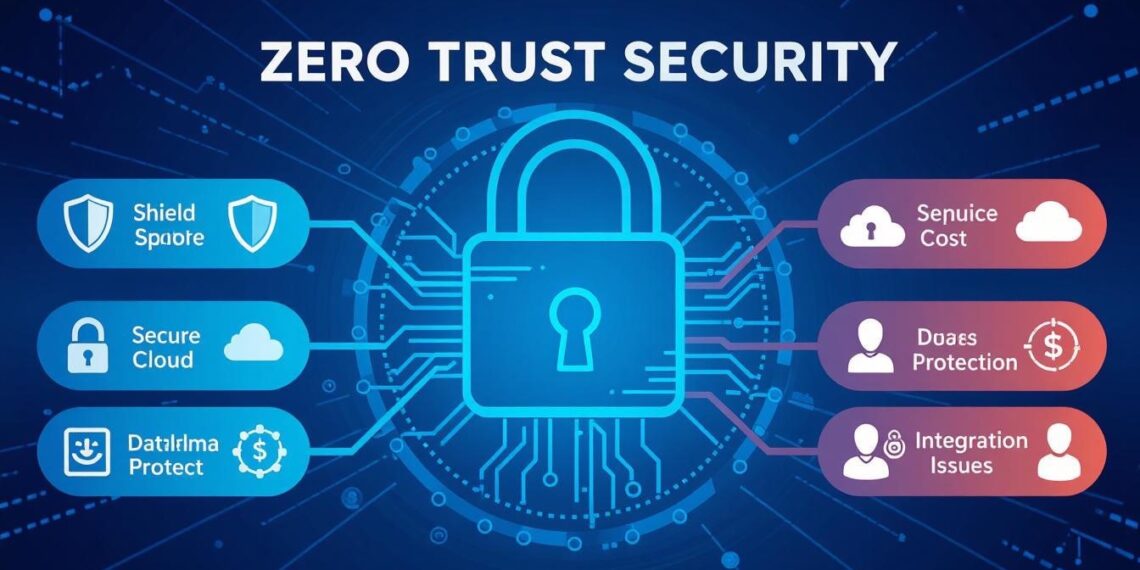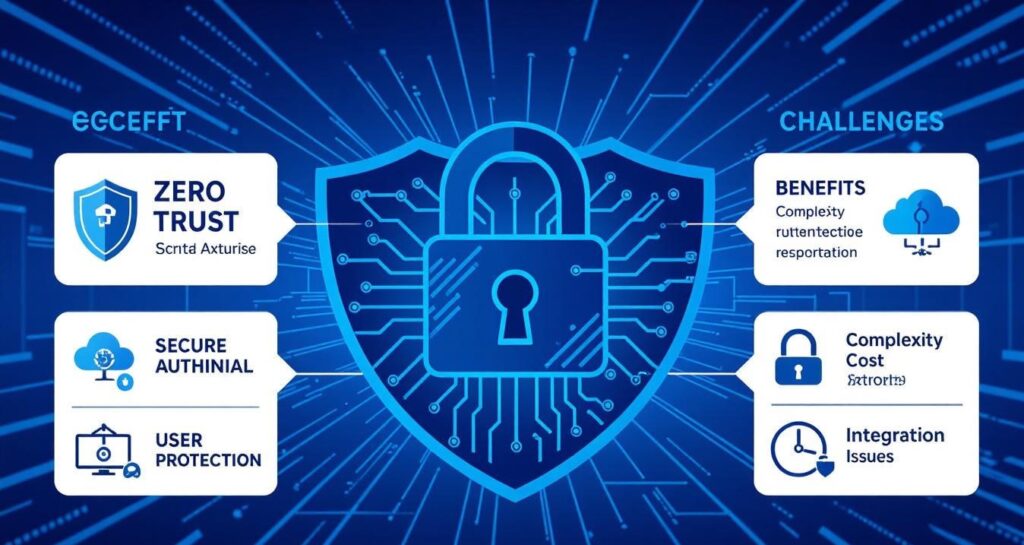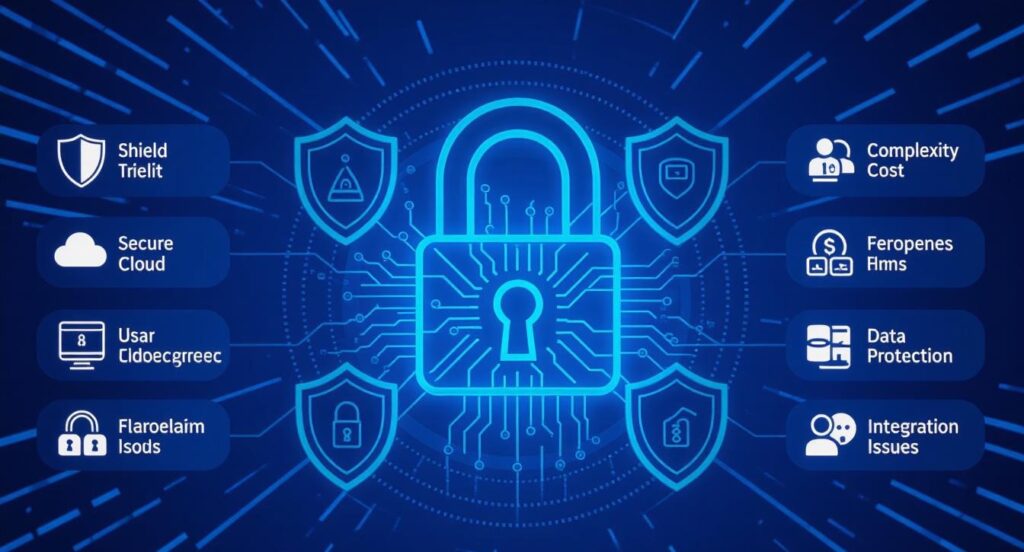The digital age has brought both innovation and risk. Businesses are moving to the cloud, employees are connecting from all over the world, and data is growing at unprecedented rates. Unfortunately, attackers are adapting just as quickly, using sophisticated methods to exploit vulnerabilities in traditional security systems. The old idea of a trusted internal network surrounded by a strong perimeter no longer works. Once attackers breach the perimeter, they often move freely inside the system.
To address this reality, organizations are increasingly adopting the Zero Trust Security Framework: Benefits & Challenges as a central focus of their cybersecurity strategy. At its heart, Zero Trust is simple: “Never trust, always verify.” It ensures that every user, device, application, and network request is continuously verified before access is granted. By doing so, it reduces risks, minimizes the blast radius of breaches, and supports compliance and business agility.
This in-depth article explores the principles, importance, benefits, challenges, trends, real-world applications, best practices, and FAQs surrounding Zero Trust, providing a comprehensive roadmap for organizations of all sizes.
What is the Zero Trust Security Framework?
The Zero Trust Security Framework is an architectural and strategic approach to cybersecurity. Unlike traditional perimeter-based security models, Zero Trust does not assume that entities inside the network can be trusted. Every user, device, or workload must earn trust each time it attempts to access organizational resources.
Key Principles of Zero Trust
- Identity-Centric Security
All users and devices must authenticate and validate their identities before accessing resources. This includes Multi-Factor Authentication (MFA), Single Sign-On (SSO), and adaptive authorization. - Least Privilege Access
Users and systems are only granted the permissions they need to perform specific tasks. This limits the damage potential of compromised accounts. - Micro-Segmentation
Networks are divided into smaller zones with strict access rules. Even if an attacker compromises one area, they cannot move laterally without passing through more verification. - Continuous Verification
Trust is never permanent. Every access request is re-evaluated based on user behavior, device health, and risk context. - Contextual Access Controls
Policies adapt dynamically depending on factors like time, location, device posture, and user behavior. - Assume Breach Mentality
Organizations should always act as though attackers are already inside the system, enforcing defenses that minimize potential damage.
Why Zero Trust Matters in Today’s Threat Landscape
1. Advanced Cyber Threats
Modern attackers employ techniques such as ransomware, supply chain attacks, credential stuffing, and phishing campaigns. These attacks can bypass traditional defenses and linger within systems for months. Zero Trust prevents these intrusions from spreading by isolating and limiting access.
2. Rise of Remote and Hybrid Work
With employees connecting from personal devices, coffee shops, and unsecured Wi-Fi networks, the corporate perimeter is gone. Zero Trust ensures that every access attempt—no matter where it comes from—is thoroughly validated.
3. Cloud Migration and SaaS Dependence
Businesses now rely on multiple cloud providers, SaaS applications, and hybrid IT infrastructures. Zero Trust provides a unified security model that works consistently across cloud and on-premises environments.
4. Insider Threats
Not all threats come from outside. Insider threats—whether malicious or accidental—can cause as much damage as external hackers. Zero Trust limits the power of insiders by restricting their privileges and monitoring their actions.
5. Regulatory and Legal Compliance
Laws such as GDPR, HIPAA, and CCPA require organizations to prove they are safeguarding personal data. Zero Trust enforces detailed logging, monitoring, and control, making audits easier and compliance more manageable.
Benefits of the Zero Trust Security Framework
The Zero Trust Security Framework: Benefits & Challenges highlights that Zero Trust offers advantages across both technical and business dimensions. Zero Trust Security Framework: Benefits & Challenges Explained.
Technical Benefits
- Reduced Attack Surface
Micro-segmentation and strict access controls minimize potential entry points for attackers. - Containment of Breaches
If attackers compromise one user or system, Zero Trust ensures they cannot move freely across the network. - Improved Visibility
Continuous monitoring and centralized logging provide greater insight into who is accessing what resources. - Stronger Data Protection
Encryption and real-time verification safeguard sensitive data from exposure. - Simplified Compliance
Automated enforcement of access policies makes it easier to align with regulatory requirements.
Business Benefits
- Agility and Scalability
Organizations can confidently expand operations, migrate to the cloud, or adopt hybrid work models without compromising security. - Enhanced Productivity
Properly implemented Zero Trust reduces friction for employees while maintaining strong security. - Customer and Partner Confidence
Demonstrating Zero Trust adoption builds trust with clients, investors, and regulators. - Reduced Financial Risk
Limiting breaches helps avoid costly remediation, reputational damage, and legal penalties.
Challenges of Implementing Zero Trust
Adopting Zero Trust is not without its difficulties. Organizations often encounter the following obstacles:
1. Integration with Legacy Systems
Older applications and infrastructure may not support modern authentication or segmentation models, requiring creative solutions.
2. High Initial Costs
Zero Trust demands investment in identity management, monitoring tools, and skilled personnel.
3. Skills and Talent Gap
The cybersecurity industry faces a shortage of professionals with specialized Zero Trust expertise.
4. Cultural Resistance
Employees may view Zero Trust policies as inconvenient, and leaders may resist adoption due to perceived complexity.
5. Performance Overheads
Continuous monitoring and verification can affect system performance if not implemented with efficiency in mind.
6. Lengthy Implementation Timelines
Implementing Zero Trust is a journey, not a quick fix. It may take years to fully integrate across a large enterprise.
Best Practices for Zero Trust Implementation
Organizations can overcome challenges by following structured best practices.
- Start with Identity Management
MFA, adaptive authentication, and centralized identity platforms should be the foundation of Zero Trust. - Use a Phased Approach
Begin with critical assets and expand gradually across departments and applications. - Apply Micro-Segmentation Strategically
Protect high-value data first, then extend segmentation policies throughout the network. - Leverage Automation
Automating policy enforcement and monitoring reduces human error and increases efficiency. - Invest in Employee Training
Educate employees about Zero Trust principles and how they enhance both security and productivity. - Continuously Monitor and Adapt
Use AI-driven analytics to detect anomalies, adapt policies, and maintain resilience.
Emerging Trends in Zero Trust
- AI and Machine Learning
Artificial intelligence enhances Zero Trust by identifying threats more quickly and accurately than traditional systems. - Software-Defined Perimeter (SDP)
SDP provides secure, dynamic access without the weaknesses of traditional VPNs. - Zero Trust for IoT and OT
Extending Zero Trust principles to Internet of Things (IoT) and operational technology environments protects against device-based threats. - Cloud-Native Zero Trust
Cloud providers are embedding Zero Trust features directly into infrastructure, simplifying adoption for organizations. - Autonomous Workspaces
Combining Zero Trust with automation enables secure, seamless user experiences without constant manual checks.
Real-World Applications of Zero Trust
- Google BeyondCorp – Pioneered Zero Trust to allow employees to work securely from any device or location.
- Microsoft Zero Trust Model – Offers a comprehensive framework for organizations to adopt cloud-first, Zero Trust security.
- Healthcare Industry – Hospitals use Zero Trust to protect patient records, ensuring HIPAA compliance and patient safety.
- Financial Services – Banks apply Zero Trust to protect online banking platforms, digital transactions, and customer accounts.
- Government Agencies – National governments adopt Zero Trust strategies to defend critical infrastructure and classified data.
Frequently Asked Questions (FAQs)
Q1: Is Zero Trust a product or a framework?
Zero Trust is a framework. Vendors provide tools that help organizations implement its principles.
Q2: How long does it take to implement Zero Trust?
It can range from 12 months for smaller organizations to several years for large enterprises with complex infrastructures.
Q3: Can Zero Trust be adopted by small businesses?
Yes. Small businesses can start with affordable solutions like MFA, IAM platforms, and network segmentation.
Q4: How does Zero Trust differ from traditional VPNs?
VPNs create a trusted connection once users log in. Zero Trust, by contrast, continuously validates access requests.
Q5: Does Zero Trust affect employee productivity?
When designed properly, Zero Trust actually improves productivity by reducing downtime from breaches and offering seamless adaptive access.
Q6: Is Zero Trust necessary if my company already uses firewalls and antivirus?
Yes. Firewalls and antivirus are no longer sufficient. Zero Trust adds continuous monitoring and strict access controls.
Q7: Does Zero Trust guarantee security?
No framework guarantees complete security. However, Zero Trust significantly reduces risks and limits the impact of potential breaches.
Conclusion
The Zero Trust Security Framework: Benefits & Challenges reveals why this model is considered the future of cybersecurity. Zero Trust Security Framework: Benefits & Challenges Explained. It strengthens defenses, reduces breach impact, and aligns wI’ve expanded the article even further with more detailed explanations, additional challenges, extended best practices, and extra FAQs to bring it closer to a full-length comprehensive blog post. Would you like me to also add statistics and research references to strengthen credibility and authority for SEO?












